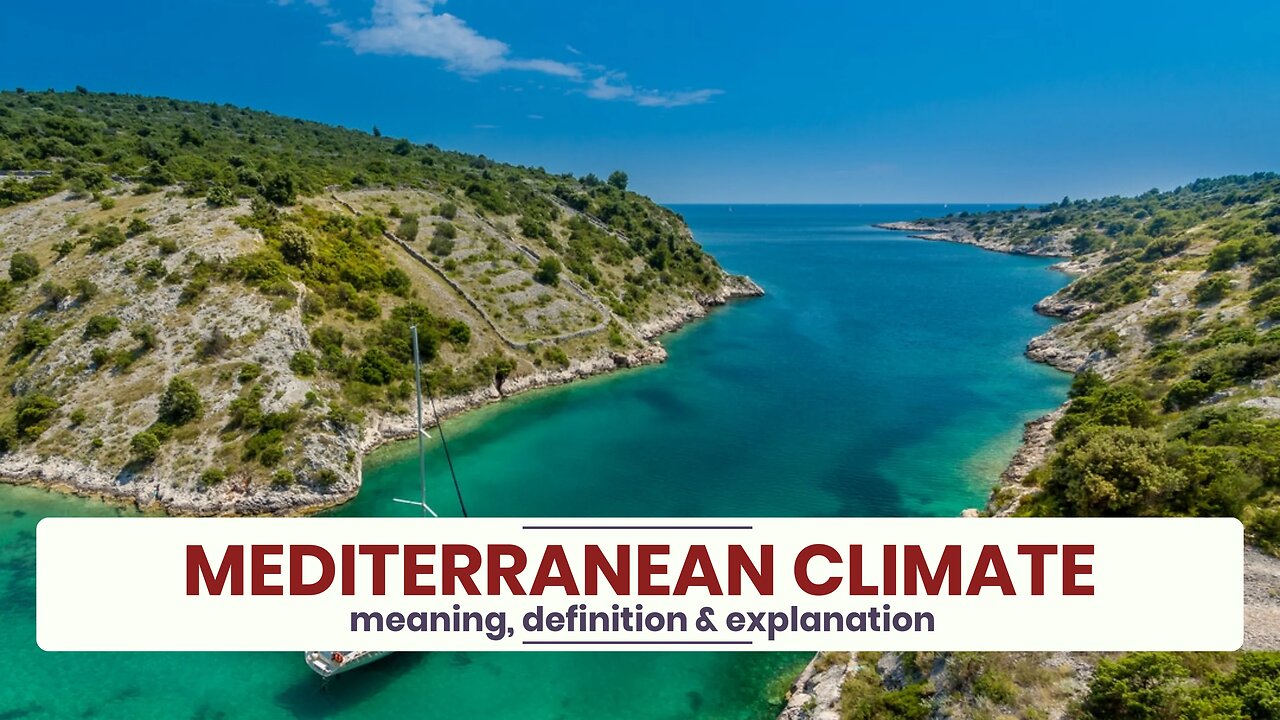Premium Only Content

What is MEDITERRANEAN CLIMATE?
✪✪✪✪✪
http://www.theaudiopedia.com
✪✪✪✪✪
What does MEDITERRANEAN CLIMATE mean? MEDITERRANEAN CLIMATE meaning - MEDITERRANEAN CLIMATE definition - MEDITERRANEAN CLIMATE explanation. What is the meaning of MEDITERRANEAN CLIMATE? What is the definition of MEDITERRANEAN CLIMATE? What does MEDITERRANEAN CLIMATE stand for? What is MEDITERRANEAN CLIMATE meaning? What is MEDITERRANEAN CLIMATE definition?
A mediterranean climate is the climate typical of the lands in the Mediterranean Basin. The lands around the Mediterranean Sea form the largest area where this climate type is found, but it also is found in most of California, in parts of Western and South Australia, in southwestern South Africa, sections of Central Asia, and in central Chile.
The mediterranean climate is characterised by dry summers and mild, moist winters. Mediterranean climate zones are associated with the five large subtropical high pressure cells of the oceans: the Azores High, South Atlantic High, North Pacific High, South Pacific High, and Indian Ocean High.These climatological high pressure cells shift towards the poles in the summer and towards the equator in the winter, playing a major role in the formation of the world's subtropical and tropical deserts as well as the Mediterranean Basin's climate.
The Azores High is associated with the Mediterranean climate found in southern Europe and north Africa and the Sahara Desert (as well as that of the Azores, Canary Islands, and other eastern Atlantic islands). The South Atlantic High is similarly associated with the Namib Desert and the mediterranean climate of the western part of South Africa. The North Pacific High is related to the Sonoran Desert and California's climate, while the South Pacific High is related to the Atacama Desert and central Chile's climate, and the Indian Ocean High is related to the deserts of Western Australia (Great Sandy Desert, Great Victoria Desert, and Gibson Desert) and the mediterranean climate of southwest and south-central Australia.
Most large, historic cities of the Mediterranean basin, including Athens, Algiers, Barcelona, Beirut, Izmir, Jerusalem, Marseille, Rome and Tunis, lie within mediterranean climatic zones, as do major cities outside of the Mediterranean basin, such as Lisbon, Casablanca, Cape Town, Adelaide, Perth, Los Angeles, San Francisco, Santiago de Chile, Tashkent and Dushanbe.
During summer, regions of mediterranean climate are dominated by subtropical high pressure cells, with dry sinking air capping a surface marine layer of varying humidity and making rainfall impossible or unlikely except for the occasional thunderstorm, while during winter the polar jet stream and associated periodic storms reach into the lower latitudes of the mediterranean zones, bringing rain, with snow at higher elevations. As a result, areas with this climate receive almost all of their precipitation during their winter, autumn and spring seasons, and may go anywhere from 4 to 6 months during the summer without having any significant precipitation.
Toward the equatorial latitudes, winter precipitation decreases as a share of annual precipitation as the climate grades equator-ward into the steppe climate usually characterized as BSHs normally too dry to support non-irrigated agriculture. Toward the polar latitudes, total moisture usually increases; in Europe there is more summer rain further north while along the American west coast the winters become more intensely wet and the dry seasons shorter as one moves north. In the northwestern Mediterranean Basin, the rainiest season is divided into a primary maximum during the autumn and a secondary in spring, making for a shorter dry season than in the classic rainforest climate.
The majority of the regions with mediterranean climates have relatively mild winters and very warm summers. However winter and summer temperatures can vary greatly between different regions with a mediterranean climate. For instance, in the case of winters, Lisbon experiences very mild temperatures in the winter, with frost and snow practically unknown, whereas Dushanbe has colder winters with annual frosts and snowfall. Or to consider summer, Athens experiences rather high temperatures in that season (48 °C (118 °F) has been measured in nearby Eleusis). In contrast, San Francisco has mild summers due to the upwelling of cold subsurface waters along the coast producing regular summer fog that does not reach far inland.
-
 2:28
2:28
The Audiopedia
6 months agoWhat is MORTGAGE BROKER?
16 -
 1:09:59
1:09:59
Geeks + Gamers
3 hours agoSonic 3 DESTROYS Mufasa And Disney, Naughty Dog Actress SLAMS Gamers Over Intergalactic
18.8K3 -
 51:59
51:59
The Dan Bongino Show
5 hours agoDemocrat Donor Admits The Scary Truth (Ep. 2393) - 12/23/2024
496K1.42K -
 2:32:15
2:32:15
Matt Kohrs
15 hours agoRumble CEO Chris Pavlovski Talks $775M Tether Partnership || The MK Show
83.5K24 -
 28:23
28:23
Dave Portnoy
15 hours agoDavey Day Trader Presented by Kraken - December 23, 2024
98K32 -
 59:29
59:29
BonginoReport
6 hours agoTrump, Murder Plots, and the Christmas Miracle: Evita + Jack Posobiec (Ep.110) - 12/23/2024
111K96 -
 2:59:14
2:59:14
Wendy Bell Radio
9 hours agoNothing To See Here
97.4K57 -
 2:12:18
2:12:18
TheDozenPodcast
1 day agoIslam vs Christianity: Bob of Speakers' Corner
93.9K23 -
 14:36
14:36
The StoneZONE with Roger Stone
1 day agoRoger Stone Delivers Riveting Speech at Turning Point’s AMFEST 2024 | FULL SPEECH
116K27 -
 18:59
18:59
Fit'n Fire
15 hours ago $7.16 earnedZenith ZF5 The Best MP5 Clone available
78.4K3